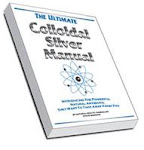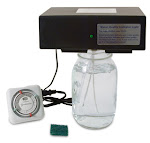Hi, Steve Barwick here, for www.TheSilverEdge.com...
I’ve got a bunch
of great short videos on making and using colloidal silver coming to the “Videos” page of
TheSilverEdge.com website.
In fact, there are 10 brand spanking new videos coming. And
I should have them all ready by the first or second week of October, 2012.
These are professionally filmed video shorts, two minutes to
five minutes each in length, on various aspects of making and using colloidal
silver.
And of course, yours
truly is doing the demonstrations in the videos!
4 Older Colloidal
Silver Videos Already Posted…
Meanwhile, in case you don’t know it, I already have four short videos on making and using
colloidal silver already posted to the “Videos” page of TheSilverEdge.com
website.
Two of these four videos were shot with my little hand-held
FlipCam. So they’re true guerrilla videos, rather than
professionally shot videos. (And I’m
afraid it shows a bit. But the
information is quite valuable if you love making your own colloidal silver.)
The other two video shorts are brief excerpts from other
longer, professionally shot videos.
So until the 10 new videos I’ve got coming are posted a few
weeks from now, I’m sure you’ll find at least several of the four videos already posted to TheSilverEdge.com
website to be eye-opening and helpful.
Here’s what you’ll find right
now at the “Videos” page of TheSilverEdge.com website:
If you prefer to make bigger batches of colloidal silver
with your new Micro-Particle Colloidal Silver Generator from The Silver Edge,
for long-term storage or for household usage, watch this short video to learn
how easy it is to make one gallon or more
at a time.
Remember, micro-particle colloidal silver is extraordinarily
stable, and therefore it can be stored for months or even years at a time
without losing potency.
What’s more, knowing how to make big batches is important,
because you’ll have so much colloidal silver available, you’ll be able to use
it for more purposes, such as disinfecting and sanitizing your kitchen and
bathroom, adding it to the mop bucket, or even adding it to the bath
water.
Indeed, many people even add a cup or two of colloidal
silver to the rinse cycle of their wash to help sanitize kitchen and bathroom
towels, undergarments, bedding and more.
The uses for colloidal silver are innumerable. And when you
can make it gallons at a time, for just pennies,
you’re obviously going to use it for more things than ever before.
What’s more, in this Age of Strange Diseases in which we
live, the more colloidal silver you have on hand is obviously the better!
And should we ever experience the much-discussed crash of
our financial system, and hospitals close, doctors go home, etc., colloidal
silver could be worth its weight in gold…quite literally!
So having the knowledge and the means to make colloidal
silver in large amounts could not only be life-saving, but profitable during a
prolonged crisis!
Inhaling colloidal silver into the lungs through a device called
a nebulizer has become a popular way of treating upper respiratory infections
through natural means.
Getting colloidal silver into the body through the lungs, without
having to go through the digestive tract, means you get more colloidal silver
directly into the bloodstream, and faster than ever before.
In this video, I demonstrate exactly how to inhale colloidal
silver using a simple nebulizer you can purchase on eBay just about any day of
the week for around $40!
WARNING: Preliminary studies conducted on animals
demonstrate that nebulizing colloidal silver on a regular daily basis over long periods of time may be harmful
to lung function.
For warnings and a discussion of the available safety data, be
sure to read my article on Using
Colloidal Silver With a Nebulizer once you’ve watched the short video
above.
One of the most frequently asked questions I get is where to
find glass production containers for making colloidal silver.
The answer is simple: Walmart!
I get almost all of my glass production containers there
because they carry the standard one-quart Ball Mason jars as well as the
one-quart Kerr pickling jars. And they’re very inexpensive!
What’s more, if you know where to look, they also carry
one-quart, two-quart and one-gallon sized glass cookie jars that work perfectly
as production containers for making colloidal silver.
And they have a variety of other glass containers in the
Crafts and Home Decor departments.
Check out the video and see for yourself as I walk you
through Walmart and show you all of the possibilities for inexpensive glass
production containers!
Now anyone can
make their own high-quality micro-particle colloidal silver at home, quickly
and easily, for less than 36 cents per
quart, with a brand new Micro-Particle Colloidal Silver Generator from
TheSilverEdge.com!
In fact, these high-quality colloidal silver generators are
so simple to operate, we have 80-plus year old grandmas using them, and
distributing colloidal silver to their children and grandchildren!
So why pay health food store vendors up to $30 for a tiny
4-ounce bottle of conventional colloidal silver when you can make super
high-quality colloidal silver yourself and your entire family, for just a few pennies per batch?
Watch this short 3-minute video to see exactly how it's
done...
More Videos Coming…
As I stated, there are 10
more great video shorts on making and using colloidal silver, coming.
And as soon as I get them back from production, and get them
posted, I’ll let you know.
Here’s a sneak peak at the colloidal silver videos coming, which you'll be able to find at this link:
- How to Make an Emergency Colloidal Silver Generator
- Heal Eye Infections With Colloidal Silver
- How to Make Colloidal Silver Toothpaste
- Healing Infected Boils With Colloidal Silver and a Clay Poultice
- Pets and Colloidal Silver
- How to Prove There’s Silver in Your Colloidal Silver Solution
- Using Colloidal Silver in a Nasal Spray Bottle for Sinus and Allergies
- How to Cure An Earache With Colloidal Silver
- How to Prove Colloidal Silver Kills Bacteria
- How to Make Your Own Colloidal Silver Gel and Colloidal Silver Soap
- Using Colloidal Silver and a Neti Pot to Relieve Stubborn Sinus Problems
Meanwhile, if you’d like to learn more about making and using colloidal silver, just visit The Silver Edge website by clicking the link in this sentence.
Yours for the safe, sane and responsible
use of colloidal silver,
Steve Barwick, author
The Ultimate Colloidal Silver Manual
The Ultimate Colloidal Silver Manual
Helpful Links:
Important Note and
Disclaimer: The contents of this Ezine have not been
evaluated by the Food and Drug Administration.
Information conveyed herein is from sources deemed to be accurate and
reliable, but no guarantee can be made in regards to the accuracy and
reliability thereof. The author, Steve
Barwick, is a natural health journalist with over 30 years of experience
writing professionally about natural health topics. He is not
a doctor. Therefore, nothing stated in
this Ezine should be construed as prescriptive in nature, nor is any part of
this Ezine meant to be considered a substitute for professional medical
advice. Nothing reported herein is
intended to diagnose, treat, cure or prevent any disease. The author is simply reporting in
journalistic fashion what he has learned during the past 17 years of
journalistic research into colloidal silver and its usage. Therefore, the information and data presented
should be considered for informational purposes only, and approached with
caution. Readers should verify for
themselves, and to their own satisfaction, from other knowledgeable sources
such as their doctor, the accuracy and reliability of all reports, ideas,
conclusions, comments and opinions stated herein. All important health care decisions should be
made under the guidance and direction of a legitimate, knowledgeable and
experienced health care professional.
Readers are solely responsible for their choices. The author and publisher disclaim
responsibility and/or liability for any loss or hardship that may be incurred
as a result of the use or application of any information included in this
Ezine.
Copyright
2012 | Life & Health Research Group, LLC | PO Box 1239 | Peoria AZ
85380-1239 | All rights reserved






.jpg)









